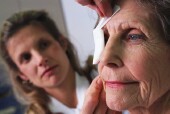
MONDAY, Oct. 11 (HealthDay News) — The number of older Americans undergoing treatment for retinal conditions such as age-related macular degeneration (AMD) and diabetic retinopathy nearly doubled between 1997 and 2007, with a significant shift in the types of procedures being performed, a new study has found.
Age-related macular degeneration is a progressive disease of the retina that causes the loss of central vision, and 40 percent of people with diabetes have some form of diabetic retinopathy, a condition in which blood vessels stop feeding the retina properly, according to the American Foundation for the Blind. Both conditions can cause vision loss and blindness.
The researchers analyzed Medicare data from 1997 to 2007 and found that the number of retinal procedures increased 192 percent during that period. The largest year-to-year increase (20 percent) occurred between 2006 and 2007, according to the study published in the October issue of the journal Archives of Ophthalmology.
The largest increase in volume was seen in treatments for neovascular, or “wet,” AMD. New treatments for this condition include intravitreal therapy — drug injections directly into the eye — of antibodies that block the formation of new blood vessels. Between 1997 and 2001, fewer than 5,000 such injections were performed each year, but rates more than doubled each year through 2006. In 2007, there were 812,413 such injections, the study authors noted in a news release from the journal’s publisher.
The use of photodynamic therapy — a laser treatment for neovascular AMD — peaked at 133,565 procedures in 2004 and then decreased 83 percent to 22,675 procedures in 2007. Laser treatment of potentially cancerous eye tumors and the “wet” form of AMD decreased from a peak of 82,089 in 1999 to 13,821 in 2007 (another 83 percent decrease), the researchers found.
Among the other findings:
- Use of vitrectomy — surgery to remove the gel inside the eye in order to treat retinal detachment — increased 72 percent between 1997 and 2007.
- The use of scleral buckling — placement of a silicon buckle around the eye — to treat retinal detachment decreased 69 percent between 1997 and 2007.
“Retinal disease is highly prevalent among older individuals, and both age-related macular degeneration and diabetic retinopathy account for more than half the irreversible blindness in older Americans. The prevalence of both macular degeneration and diabetic retinopathy increases with age, and the number of Americans affected by these conditions is expected to increase substantially as the number of Americans older than 65 years doubles from 2010 to 2040,” study author Dr. Pradeep Ramulu, of Wilmer Eye Institute at Johns Hopkins University in Baltimore, and colleagues wrote in the article.
More information
The U.S. National Eye Institute has more about age-related macular degeneration.

